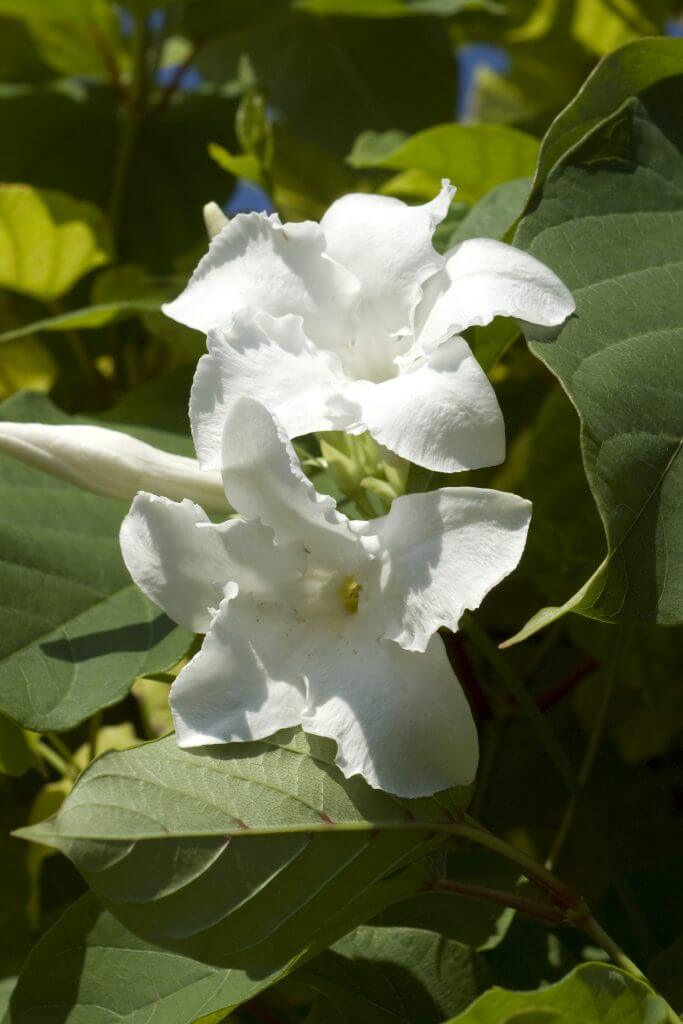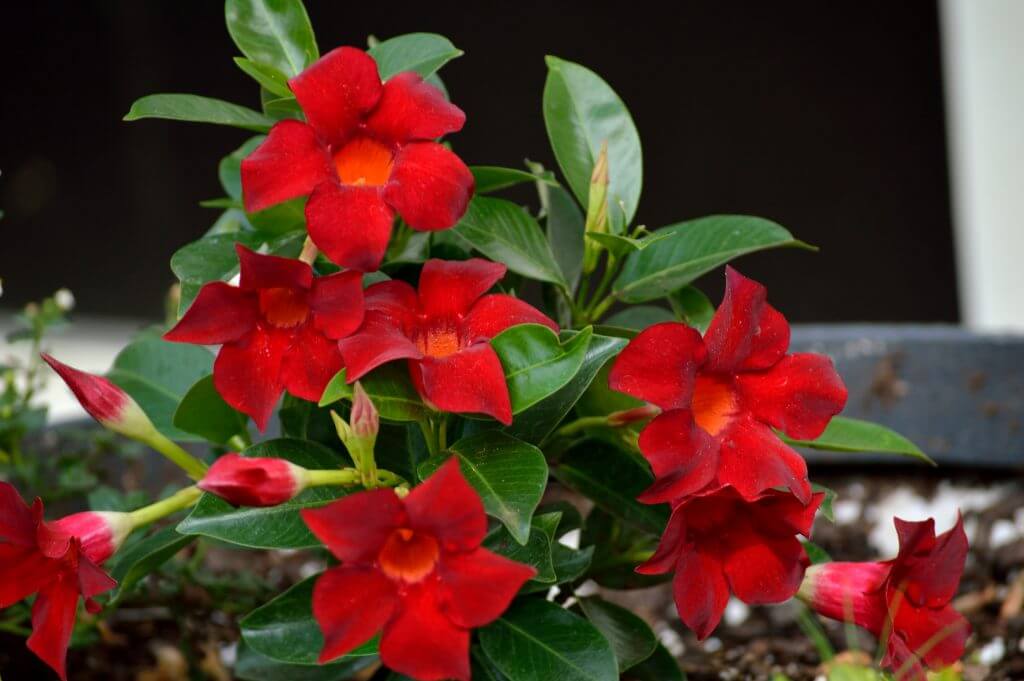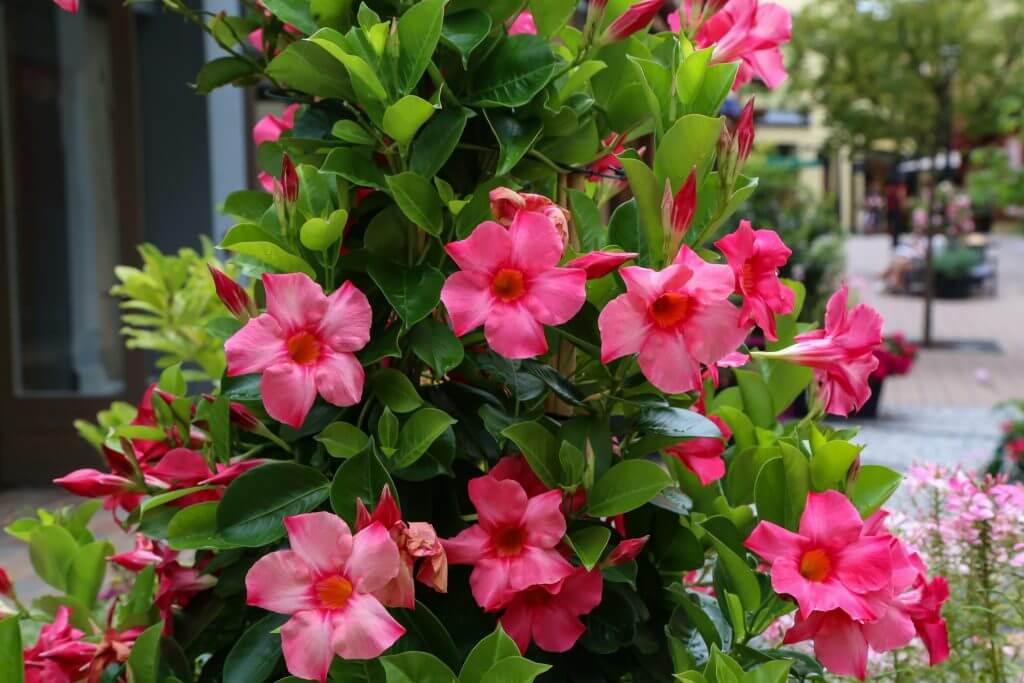The mandevilla is popular for the splash of bright tropical colours it adds to the surroundings.
The bright and striking flowers of the mandevilla make it an excellent crawler for walls or trellises.

The Basics of Mandevilla
Mandevilla, commonly known as rocktrumpet, is native to southwestern United States, Central America, Mexico, South America, and West Indies.
This genus of tropical and subtropical vines is comprised of over 170 species.
Mandevillas love warmer climates. Its blooms come in various colours such as red, yellow, pink, and white.
Some varieties have star-shaped flowers.
Mandevilla boliviensis
Also known as white mandevilla or white Dipladenia.
This woody perennial vine is native to a whole region from Costarica, down to Bolivia and Brazil.
It has glossy oval leaves, and white flowers and yellow to yellow-orange in the middle.
This mandevilla can grow up to 13 feet (4 metres). In colder climates, it grows to about half of that and may become deciduous.
White mandevilla does not tolerate freezing temperatures.


Mandevilla brachysiphon
Also known as Huachuca Mountain rocktrumpet.
This mandevilla is native to Texas, southwestern New Mexico, southern Arizona, Chihuahua, and Sonora.
This specie prefers sandy and limestone soil.
Probably one of those mandevillas that do not grow too much, this rocktrumpet rarely extends beyond 16 inches (40 cm).
Its showy white flowers open at night and produce a distinct fragrance.


Mandevilla laxa
Also known as Chilean jasmine.
This ornamental plant is native to Ecuador, Bolivia, Peru and northern Argentina.
The Chilean jasmine is deciduous in colder climates and grows to about 20 feet (6 metres).
The mandevilla laxa’s flowers come out in summer. These blooms are heavily scented and usually white.
Like a lot of mandevillas, this one does not tolerate freezing temperatures.


Mandevilla sanderi
Also known as Brazilian jasmine.
This mandevilla is native to Rio de Janeiro, Brazil.
This creeping perennial plant grows rapidly, at about 2 feet (60 cm) each year.
It has a naturally bushy habit and grows to about 6 to 10 feet (2 to 3 m) high, and can even grow to about 15 feet (4.5 m) if the conditions are optimal.
The mandevilla sanderi has glossy, thick, and leathery dark green leaves that grow to about 2.5 inches (6 cm) long.
Brazilian jasmines have pink or red flowers that are about 1.5 to 3 inches (1.5 to 7.6 cm) in diameter.


Mandevilla splendens
Also known as shining mandevilla.
This specie of mandevilla is an evergreen native to Brazil
and can grow up to 9.8 feet (3 m) high.
Its glossy green leaves are either rectangular or elliptical and grow to about 7.9 inches (20 cm).
Its rose-pink flowers have yellow a centre and bloom in late spring or early summer.
The shining mandevilla prefers temperatures above 41 °F (5 °C).


Planting Your Mandevilla
Plant your mandevillas at the start of summer, or even in late spring. You can plant them as long as the weather is warmer. These tropical flowering vines do not like cold weather.
Mandevillas prefer naturally-rich, well-draining, and sandy soil. Some recommend a mix of two parts potting soil or peat moss to one part builder’s sand.
Choose the right location for your mandevilla where it can get filtered or indirect sunlight. Full sun or direct sunlight could burn your plant.
Make sure that your mandevilla vines have the support they can crawl on such as a trellis, poles, or even short fences.
Mandevillas also look great planted in containers, especially hanging pots.
Caring for Your Mandevilla
Feed your mandevilla vine high phosphorus and water-soluble fertiliser every couple of weeks for vigorous flowering in the summer.
Prune your mandevilla by pinching to encourage bushier and fuller growth. Pinch about ¼ to ½ inch (0.6 to 1 cm) from the end of the stem.
Remove dead leaves in spring, when temperatures are above 50 °F (10 °C).
If possible, bring your mandevilla indoors when the temperature drops to below 50 °F (10 °C). Place the plants in a bright sunny position but away from direct sunlight once indoors.
If the mandevillas are planted on the ground, cover them with a sheet when temperatures begin to drop to protect them from early frost.
Water your mandevillas when the soil surface dries to the touch. Keep them barely moist while indoors.
Take the plants outside or remove the cover when spring comes and the weather gets warmer.
Common Problems with Mandevilla
Mandevillas attract mealybugs and scales. Treat with the appropriate insecticide as soon as you detect the issue. Other mandevilla pests are whiteflies and aphids. Neem oil or other pesticides can work on these.
[elementor-template id=”4604″]
[elementor-template id=”6387″]
